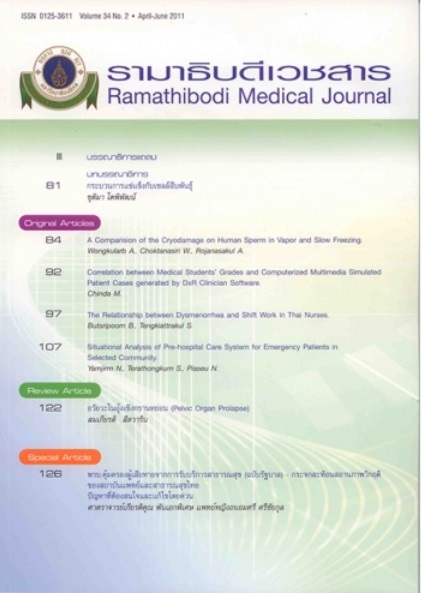กระบวนการแช่แข็งกับเซลล์สืบพันธุ์
Keywords:
กระบวนการ, แช่แข็ง, เซลล์สืบพันธุ์Abstract
ในทศวรรษปัจจุบันกระบวนการแช่แข็ง (Cryopreservation) ได้กลายเป็นหัวใจสำคัญของเวชศาสตร์การเจริญพันธ์ (Reproductive medicine) เพื่อใช้ในการดูแลและเก็บรักษาเซลล์ เนื้อเยื้อ หรือวัยวะต่างๆทั้งในพืช สัตว์ รวมถึงมนุษย์ ความรู้วิทยาศาสตร์สาขานี้เริ้มต้นปลายทศวรรษ 1940 นักวิทยาศาสตร์มีความพยายามที่จะทำการแช่แข็งเซลล์อสุจิเป็นอันดับแรก แต่ไม่ประสบความสำเร็จเท่าที่ควร จนกระทั่งภายหลังจากมีการค้นพบสารประกอบที่ใช้ป้องกันการบาดเจ็บเสียหายอันเกิดจากกระบวนการแช่แข็ง (Cryoprotective agent) ซึ่งเป็นการค้นพบครั้งสำคัญที่ทำให้การแช่แข็งประสบความสำเร็จมากขึ้น(1) ตั้งแต่นั้นมา จึงมีการพยายามที่จะทำการศึกษาวิจัยเพื่อนำกระบวนการแช่แข็งมาใช้ประโยชน์ในทางการแพทย์ กสิกรรม และอุตสาหกรรมในด้านอื่นๆ
ปัจจุบันทางการแพทย์ได้มีการนำวิทยาศาสตร์สาขานี้มาประยุกต์ใช้กันอย่างแพร่หลาย โดยมีวัตถุประสงค์หลักเพื่อช่วยในการดำรงความสามารถในการสืบพันธ์ของมนุษย์ มีรายงานถึงความสำเร็จของการแช่แข็งอสุจิมนุษย์ที่นานที่สุดถึง 21 ปี ดังจะเห็นได้จากประโยชน์ของการแช่แข็งอสุจิมาใช้ได้หลายประการ เช่น ใช้ตั้งธนาคารอสุจิเพื่อที่เก็บรักษาอสุจิบริจาค หรือกรณีที่สามีไม่สามารถมาเก็บน้ำเชื้อสดได้ในวันที่ภรรยามีการตกไข่ รวมถึงเป็นอีกทางเลือกสำหรับผู้ชายที่วางแผนที่จะมีบุตรในอนาคต ที่จำเป็นต้องได้รับการรักษาโรคบางอย่างซึ่งอาจส่งผลต่อการสร้างอสุจิของอัณฑะ เช่น การผ่าตัด การฉายรังสี และการได้รับยาเคมีบำบัด เป็นต้น
References
Polge C, Smith AU, Parkes AS. Revival of spermatozoa after vitrification and dehydration at low temperatures. Nature. 1949;164(4172):666. doi:10.1038/164666a0.
Steptoe PC, Edwards RG. Birth after the reimplantation of a human embryo. doi:10.1016/s0140-6736(78)92957-4.
Pegg DE. The history and principles of cryopreservation. Semin Reprod Med. 2002;20(1):5-13. doi:10.1055/s-2002-23515.
Pegg DE. Principles of cryopreservation. Methods Mol Biol. 2007;368:39-57. doi:10.1007/978-1-59745-362-2_3.
Gao D, Critser JK. Mechanisms of cryoinjury in living cells. ILAR J. 2000;41(4):187-96. doi:10.1093/ilar.41.4.187.
Asahina E, Shimada K, Hisada Y. A stable state of frozen protoplasm with invisible intracellular ice crystals obtained by rapid cooling. Exp Cell Res. 1970;59(3):349-58. doi:10.1016/0014-4827(70)90641-5.
Kasai M, Ito K, Edashige K. Morphological appearance of the cryopreserved mouse blastocyst as a tool to identify the type of cryoinjury. Hum Reprod. 2002;17(7):1863-74. doi:10.1093/humrep/17.7.1863.
Mazur P, Leibo SP, Chu EH. A two-factor hypothesis of freezing injury. Evidence from Chinese hamster tissue-culture cells. Exp Cell Res. 1972;71(2):345-55. doi:10.1016/0014-4827(72)90303-5.
McGann LE, Yang HY, Walterson M. Manifestations of cell damage after freezing and thawing. Cryobiology. 1988;25(3):178-85. doi:10.1016/0011-2240(88)90024-7.
Wusteman MC, Pegg DE, Robinson MP, Wang LH, Fitch P. Vitrification media: toxicity, permeability, and dielectric properties. Cryobiology. 2002;44(1):24-37. doi:10.1016/S0011-2240(02)00002-0.
Whittingham DG, Leibo SP, Mazur P. Survival of mouse embryos frozen to -196 degrees and -269 degrees C. Science. 1972;178(4059):411-4.
Rall WF, Fahy GM. Ice-free cryopreservation of mouse embryos at -196 degrees C by vitrification. Nature. 1985;313(6003):573-5.













